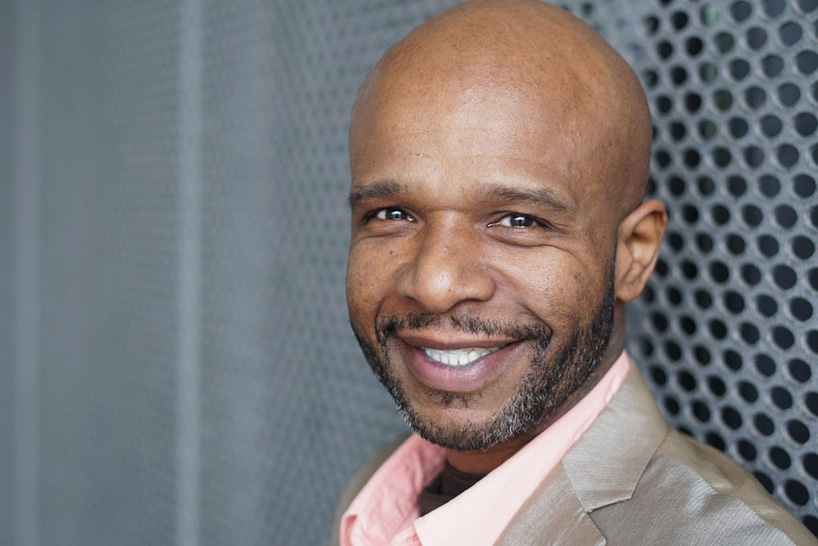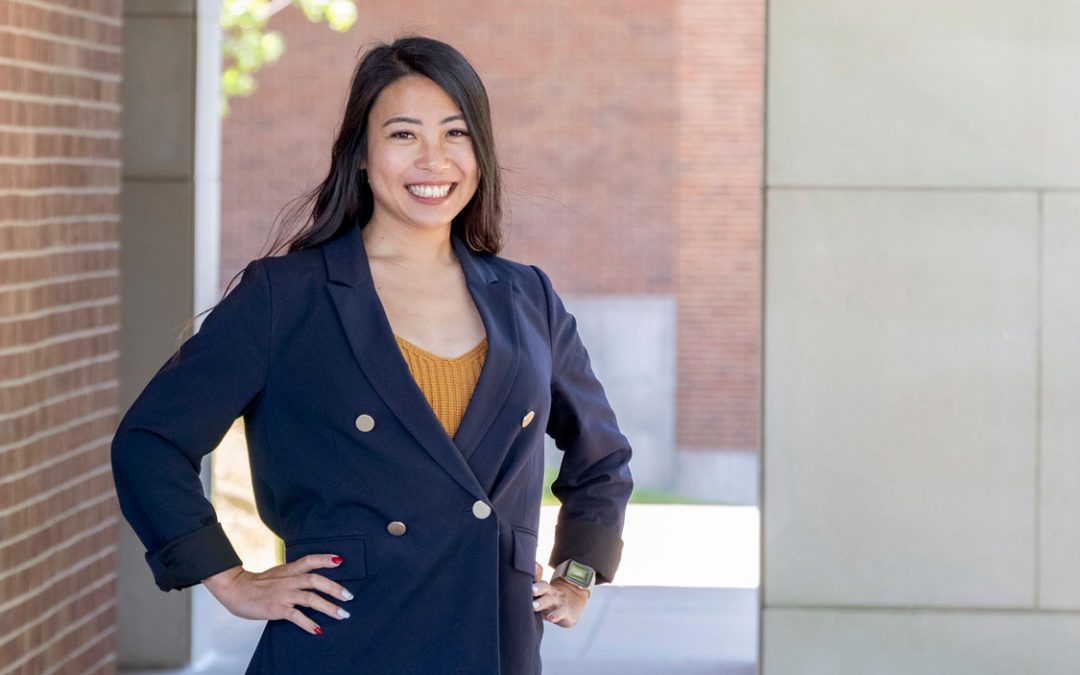
Napoleon Williams III defended his dissertation titled “Role of Municipal Governance in Stabilizing Mature Inner Suburbs: A Study of Five St. Louis Municipalities 1970-2015. (Photo courtesy of Napoleon Williams III)
In 2014, as protests roiled the streets of Ferguson and were broadcast on newscasts across the country in the wake of the killing of Michael Brown, Napoleon Williams III found himself looking for ways to help.
Williams was already enrolled as a doctoral student in the Department of Political Science at the University of Missouri–St. Louis, and his day job had him serving as the director of advocacy and outreach at Connections to Success, a local nonprofit working to help individuals break out of the cycle of poverty.
“I was on the ground working with organizations, churches, government officials and cities, trying to identify areas of need where we could actually provide things like job training, how to fill out an application, how to dress for an interview and go on an interview and gain education and career opportunities,” Williams said.
All those were in high demand in a community with a poverty rate of 22.5 percent, the majority of it concentrated on the city’s predominantly African American east side where Brown was killed and the protests were then centered.
The more time Williams spent in Ferguson, and the more people he talked to, the more he found himself wondering how the community had become the center of national attention. Its deep divisions along racial and socioeconomic lines undergirded the unrest then spreading more broadly across the United States.
Ultimately, he decided to try to find an answer.
That launched Williams into a deep dive examining the actions of the municipal government and then comparing them to what other nearby communities had done. The result, five-plus years later, was a more than 300-page dissertation titled “Role of Municipal Governance in Stabilizing Mature Inner Suburbs: A Study of Five St. Louis Municipalities 1970-2015.”
Williams successfully defended the work in late July in the final step toward earning his PhD.
“He has wrapped up and written an excellent dissertation,” said Todd Swanstrom, the E. Desmond Lee Endowed Professor in Community Collaboration and Public Policy, who served as the chair of Williams’ dissertation advisory committee. “He was able to apply his analytical intelligence to a social justice issue.”
“He’s clearly driven by issues of social justice and racial inequity in St. Louis, but he was able to step back and do this incredible piece of research that’s incredibly detailed. There’s reason to believe he could publish it as a book.”
Challenging narratives
Williams’ work fits into a gap in research on how suburban communities have changed as a result of racial integration that occurred as more and more African Americans moved away from urban centers starting in the 1960s.
“I had begun to hear a lot of the narrative around what actually happened within these communities over the course of decades,” Williams said. “I wanted to dig in and see what really occurred and see if I could pinpoint specifically the role of local governments.”
“I understand that there’s a plethora of other factors contributing to conditions, but I felt it was a bit simplistic in terms of the way it was being presented publicly.”
In some cases, the changing demographics have led to racial tipping as white Americans left those communities for more far-flung, overwhelmingly white suburbs. Often left behind are communities with flat or declining property values and increasing poverty.
But there are also municipalities that have thrived as they’ve become more diverse over the past five decades.
Williams’ research suggests that’s not an accident or dumb luck. Rather, it’s the result of active steps municipal governments have taken – positively or negatively –to deal with integration.
Different policies, divergent outcomes
In his study, Williams looked not only at Ferguson but also at the Missouri suburbs of University City, Maplewood, Hazelwood and Jennings.
University City, in particular, has been lauded as a community that successfully integrated. Of its nearly 35,000 residents, today nearly 40 percent are African American. The poverty rate – 15.8 percent – remains higher than the national average, but the median income is $57,546, and the average median property value is $238,500, nearly three times that of Ferguson.
“University City did not have an easy trek,” Williams said. “People talk about how they had all these liberal progressives, and they were great people. That’s not entirely true. People in University City like to think that about themselves that way, but even if there were people in the 1960s who believed in integration and in this utopian world, there were thousands of University City residents that did not see it that way. They did not want a black person living on their street. They did not want their child going to school with a black child.”
Despite such feelings among some of its residents, University City’s municipal government implemented an open housing policy and encouraged African Americans to move into the community even as it required occupancy permits and stringent housing codes for inspections.
As the apartment boom began in the 1970s and 1980s, attracting more lower-income residents, University City dispersed many of those rental properties throughout the community, amid family-owned homes.
“What distinguished Ferguson is that they had an actual, concerted effort to prevent the influx of African Americans, and you see it through policies,” said Williams, who went back through the transcripts of decades of public hearings in addition to interviewing people who lived through that era.
African Americans still moved into Ferguson amid the large-scale migration from urban centers. But they wound up being concentrated in a low-income part of the city, leading to greater segregation and income inequality that got compounded over time, leading to the destabilization of the community.
Eventually, that set the conditions for the unrest that exploded onto national newscasts in 2014 and 2015.
“His work has a good, provocative thesis that it’s much better to adapt and respond to and even welcome change than to try to push it away,” Swanstrom said.
Williams is humble enough in his analysis not to suggest everything would have turned out otherwise if only Ferguson’s municipal government had acted differently decades earlier.
“What I found was that to bring about neighborhood stabilization, you need so many factors – from the municipal governance level, to the citizen level, to the economic environment, to the natural environment,” Williams said. “All of these things needed to align in order to bring about neighborhood stabilization. However, with neighborhood decline or deterioration, bad policy alone can be enough.”
Changing plans
Studying this history was personal for Williams, who grew up in north St. Louis and has witnessed the ramifications of these policy decisions on the broader region.
Williams attended Harris-Stowe State University, where he earned a degree in social and behavioral sciences with the intention of one day going to law school.
One of his professors, Mark Abbott, pushed him to consider a different path.
“He truly believed that with my spirit and my position and my views on things, I would not serve the world and the community by going into law,” Williams said. “I’m very good at litigating what is already established, but he really saw my fire to bring awareness to what the problems are with the existing laws.”
Whether it was intentional or not, Abbott also wound up steering Williams toward UMSL for his doctoral work by introducing him to Swanstrom and Professor Emeritus Terry Jones, who would both go on to serve on his dissertation committee.
Williams was still an undergraduate in 2011 when Abbott invited him to have lunch with all three men. He had read some work by Swanstrom and by Jones during the course of his studies but hadn’t realized they were local scholars until something clicked during their conservation in the middle of that meal. They left a strong impression.
Leaving behind the idea of law school, UMSL’s Department of Political Science quickly emerged as the logical next stop in Williams’ academic journey.
He has no regrets about the decision.
“It’s been the most illuminating time in my life,” Williams said. “I’ve been able to see so many different perspectives and see so many different potential factors in the most granular of issues. You learn how to look at some fundamental thing that’s accepted worldwide and either challenge that or have it confirmed. Either way, it’s always a great feeling.”
“This process has been just filled with those experiences throughout my entire time.”
He will carry that with him as he plots his next career move, either applying for an academic appointment or pursuing work as a policy consultant.














